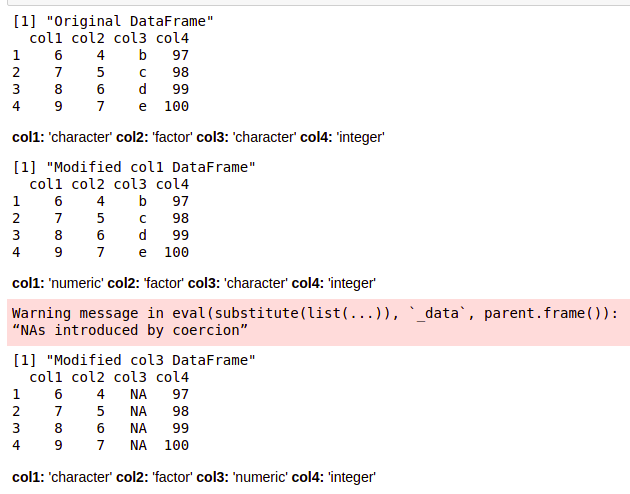R语言 如何将DataFrame列从字符转换为数字
在这篇文章中,我们将讨论如何在R编程语言中把DataFrame列从字符转换为数字。
所有的数据框架列都与一个类相关联,这个类是该列元素所属的数据类型的指标。因此,为了模拟数据类型转换,在这种情况下,数据元素必须被转换为所需的数据类型,即该列的所有元素都应该有资格成为数值。
注意: sapply()方法可以用来检索向量形式的列变量的数据类型。
方法1:使用 transform()方法
字符类型的列,无论是单个字符还是字符串,只有在这些转换是可能的情况下才能转换成数字值。否则,数据就会丢失,并在执行时被编译器胁迫为缺失或NA值。
这种方法描述了由于插入缺失或NA值来代替字符而造成的数据损失。这些NA值的引入是因为相互转换是不可能直接实现的。
# declare a dataframe
# different data type have been
# indicated for different cols
data_frame <- data.frame(
col1 = as.character(6 : 9),
col2 = factor(4 : 7),
col3 = letters[2 : 5],
col4 = 97 : 100, stringsAsFactors = FALSE)
print("Original DataFrame")
print (data_frame)
# indicating the data type of
# each variable
sapply(data_frame, class)
# converting character type
# column to numeric
data_frame_col1 <- transform(data_frame,
col1 = as.numeric(col1))
print("Modified col1 DataFrame")
print (data_frame_col1)
# indicating the data type of
# each variable
sapply(data_frame_col1, class)
# converting character type column
# to numeric
data_frame_col3 <- transform(data_frame,
col3 = as.numeric(col3))
print("Modified col3 DataFrame")
print (data_frame_col3)
# indicating the data type of each
# variable
sapply(data_frame_col3, class)
输出 。

解释 :使用sapply()方法,数据框架col3的类是一个字符,也就是由单字节的字符值组成,但是在应用transform()方法时,这些字符值被转换成缺失或NA值,因为字符不能直接转换为数字数据。所以,这导致了数据丢失。
可以通过不使用stringAsFactors=FALSE来进行转换,然后首先使用as.factor()隐含地将字符转换为因子,然后使用as.numeric()转换为数字数据类型。即使在这种情况下,关于实际字符串的信息也会完全丢失。然而,数据变得模糊不清,并可能导致实际数据丢失。数据只是根据列值的lexicographic排序结果被赋予数字值。
# declare a dataframe
# different data type have been
# indicated for different cols
data_frame <- data.frame(
col1 = as.character(6 : 9),
col2 = factor(4 : 7),
col3 = c("Geeks", "For", "Geeks", "Gooks"),
col4 = 97 : 100)
print("Original DataFrame")
print (data_frame)
# indicating the data type of
# each variable
sapply(data_frame, class)
# converting character type column
# to numeric
data_frame_col3 <- transform(data_frame,
col3 = as.numeric(as.factor(col3)))
print("Modified col3 DataFrame")
print (data_frame_col3)
# indicating the data type of each
# variable
sapply(data_frame_col3, class)
输出 。
[1] "Original DataFrame"
col1 col2 col3 col4
1 6 4 Geeks 97
2 7 5 For 98
3 8 6 Geeks 99
4 9 7 Gooks 100
col1 col2 col3 col4
"factor" "factor" "factor" "integer"
[1] "Modified col3 DataFrame"
col1 col2 col3 col4
1 6 4 2 97
2 7 5 1 98
3 8 6 2 99
4 9 7 3 100
col1 col2 col3 col4
"factor" "factor" "numeric" "integer"
解释 :col3中的第一个字符串和第三个字符串是相同的,因此分配了相同的数字值。总的来说,这些数值是按升序排序的,然后分配给相应的整数值。”For “是以词法顺序出现的最小的字符串,因此,分配的数值是1,然后是 “Geeks”,这两个实例都被映射为2,”Gooks “被分配的数值是3,因此,col3的类型变成了数值。
方法2:使用 apply()方法
R中的apply()方法允许将一个函数同时应用于多个列。该函数可以是用户定义的,也可以是内置的,取决于用户的需要。
语法: apply ( df , axis , FUN)
参数 :
- df – 要应用该函数的数据框架
- axis – 应用该函数的轴
- FUN– 用户定义的应用方法
例子 。
# declare a dataframe
# different data type have been
# indicated for different cols
data_frame <- data.frame(
col1 = as.character(6:9),
col2 = as.character(4:7),
col3 = c("Geeks","For","Geeks","Gooks"),
col4 = letters[1:4])
print("Original DataFrame")
print (data_frame)
# indicating the data type of each
# variable
sapply(data_frame, class)
# defining the vector of columns to
# convert to numeric
vec <- c(1,2)
# apply the conversion on columns
data_frame[ , vec] <- apply(data_frame[ , vec,drop=F], 2,
function(x) as.numeric(as.character(x)))
print("Modified DataFrame")
print (data_frame)
# indicating the data type of each variable
sapply(data_frame, class)
输出 。
[1] "Original DataFrame"
col1 col2 col3 col4
1 6 4 Geeks a
2 7 5 For b
3 8 6 Geeks c
4 9 7 Gooks d
col1 col2 col3 col4
"factor" "factor" "factor" "factor"
[1] "Modified DataFrame"
col1 col2 col3 col4
1 6 4 Geeks a
2 7 5 For b
3 8 6 Geeks c
4 9 7 Gooks d
col1 col2 col3 col4
"numeric" "numeric" "factor" "factor"
说明 :col1和col2类型被转换为数字。然而,这个方法适用于转换为字符的纯数字数据。在执行col3和col4的时候,它抛出了一个错误 “由强制引入的NA”。
 极客教程
极客教程